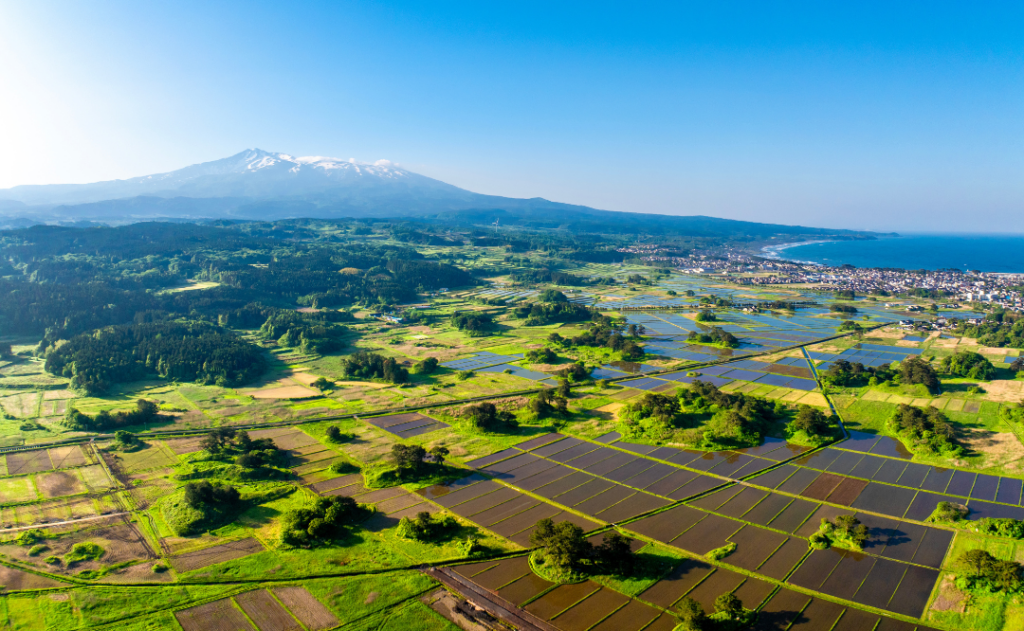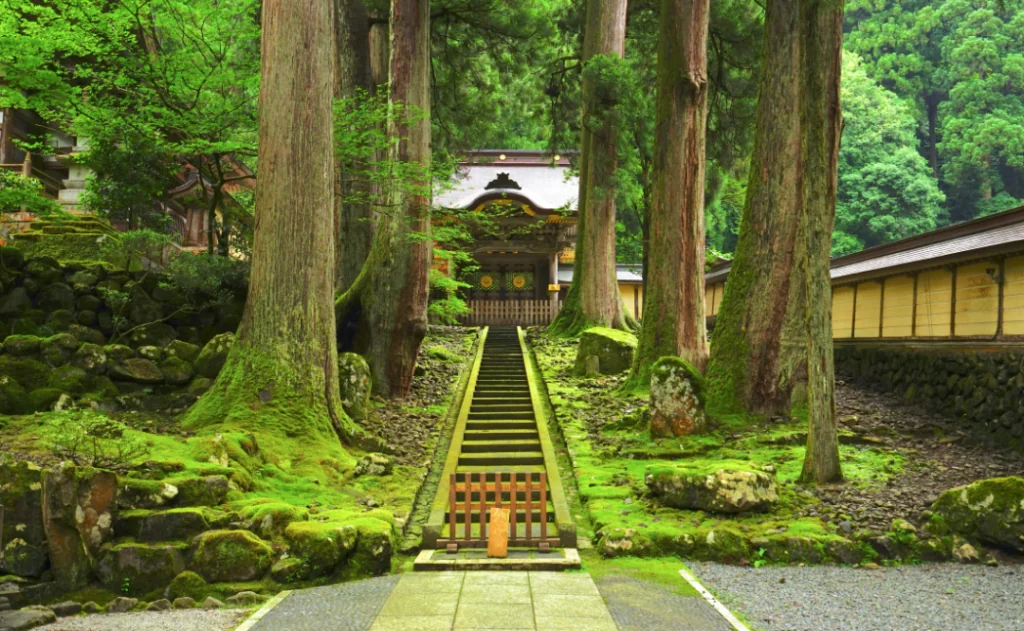Like all popular tourist destinations, Japan’s top spots get crowded with visitors, making for long lines and crowded streets. While Mount Fuji and Tokyo have their benefits, other places are just as breathtaking. Head to some of these lesser-known spots in Japan to escape the crowds.
Northern Treasures: Tohoku Region
Yamagata Prefecture

Located about three hours from Tokyo by Japan’s shinkansen (bullet train), Yamagata Prefecture is bordered by the Sea of Japan to the west and mountains to the east. It is one of Japan’s premier fruit-growing regions, is known for its hot springs, and is one of the snowiest areas of Japan. Check out the historic temple of Yamader, which dates back to 860, and is where haiku writer Basho wrote one of his most famous haikus. Climb the 1015 steps through cedar forests for panoramic views of Yamagata Valley. Check out Ginzan Onsen, a hot spring town with gas-lit streets. Famous for cherries in June, grapes in September, as well as producing sake, foodies will love visiting as well.
Best Time to Visit: Late June to early October
Recommended Hotel: Fujiya Inn
Balancing modern conveniences with traditional hospitality, this hotel features private hot tub baths and kaiseki meals (traditional multi-course meal featuring local ingredients). Centrally located in Ginzan Onsen.
Akita Prefecture

Located in the northern Tohoku region, Akita Prefecture is known for its quality rice and traditional folk cultures. In southeastern Akita, you’ll find the Kakunodate samurai district, home to six original samurai residences from the Edo Period (1603-1868). Nyuto Onsen is home to remote hot springs, many dating to the 17th century. Michinoku’s Namahage Sedo Festival in February has been named a UNESCO Intangible Cultural Heritage event, and you can watch Namahage demons dancing under bush lanterns. The main event is held at the Mayama Shrine on the Oga peninsula.
Recommended Hotel: Route Inn Grantia Akita Spa Resort
This hotel has an indoor mineral hot spring for guests to use, an on-site spa, and modern conveniences. It’s located on the West Coast, yet it will provide an excellent base for your Akita vacation.
Best Time to Visit: February for festivals, July-August for summer events
Central Japan’s Secret Spots
Toyama Prefecture

Located about 2 hours by train from Tokyo, Toyama Prefecture is located on the coast of the Sea of Japan and offers some of the most fantastic train rides in the country thanks to the Kurobe Gorge Railway. Take a ride and see sites like the Unazuki Dam, Shin-Yanagawara Power Plant, and Shin-Yamabiko Bridge. Toyama is also home to a UNESCO-listed gassho-zukuri house village, Gokayama. Gasso-zukuri translates to “hands in prayer,” given to them thanks to their pointed roofs, looking like two hands in prayer. Over two hundred years old, these buildings have thatched roofs, sliding doors, and an attic space explicitly designed for silkworm cultivation. The seafood in Toyama is exceptional, as the coastal fishing villages serve fresh fish caught in Toyama Bay.
Best Time to Visit: April-November (avoiding winter snow)
Recommended Hotel: Hotel Morinokaze Tateyama
With stunning mountain views and proximity to the Tateyama Kurobe Alpine Route, this hotel provides excellent accommodation for your Toyama stay. It offers a shuttle to local attractions, hot spring facilities, complimentary breakfast, and an on-site restaurant.
Fukui Prefecture

About three hours from Kyoto by train, Kukui Prefecture is known for its dinosaur fossils, Buddhist temples, and traditional paper-making villages. The Fukui Prefectural Dinosaur Museum is one of the world’s three largest dinosaur museums and is built near the location where Japan’s first dinosaur fossils were found. Visitors can visit Field Station to learn how fossils are excavated and studied, view the exhibition with fossils, life-sized models, and more. Visit Eihei-ji, an 800-year-old Buddhist temple. Keep in mind that tourists are frowned upon at the temple, and since 1244, “its halls have been filled with the sincere atmosphere of Zen practitioners unceasingly carrying out the Buddha’s teaching.” They do offer programs to those wishing to practice. Echizen is home to sixty-seven paper mills, and its streets are filled with artisans selling their paper products.
Best Time to Visit: March-May or October-November
Recommended Hotel: Hakujukan
Located on the grounds of the Eihei-ji Temple, this hotel allows guests to experience the temple firsthand, offering early morning meditation sessions, the use of a “Zen Concierge” to allow for a full zen experience, includes a complimentary breakfast, and all of the modern conveniences combined with a truly relaxing experience.
Southern Comfort: Kyushu’s Hidden Corners
Miyazaki Prefecture

Seven hours from Tokyo by train, Miyazaki has a tropical climate, with surfing and beaches alongside mythological and historic sites. Visit the Ancient Takachiho Gorge, where (according to legend) sun goddess Amaterasu hid in a cave and plunged the world into darkness. The gorge was formed by volcanic activity by Mount Aso. Head to Udo Shrine, said to be the birthplace of Emperor Jimmu’s father. For adventure, head to Kisakihama Beach for some surfing.
Best time to visit: October-April (avoiding summer humidity)
Recommended Hotel: Takachiho RyokanShinsen
Overlooking the Takachiho Gorge, this hotel offers rooms with private open-air baths and stunning views of the surrounding mountains. Arrange a private viewing of a Kagura dance performance with the staff, and enjoy a bite to eat at the on-site cafe.
Saga Prefecture

Located 40 minutes by train from Fukuoka, Saga Prefecture is known for its pottery towns, hot springs, and historical Dutch trading. Arita is known as the birthplace of Japanese porcelain, and is home to the Kyushu Ceramic Museum, where you can learn about the history of the art. Porcelain shops dot the streets, and villages like Okawachiyama are also brimming with pottery history beyond Arita. Visit the Yutoku Inari Shrine, one of Japan’s three Inari shrines, built into the steep hillside of a valley.
Best Time to Visit: Year-round, avoiding June (rainy season)
Recommended Hotel: Wataya Besso
Combining modern necessities with Japanese tradition, this hotel features an indoor hot spring, Japanese garden, on-site spa, and two on-site restaurants.
Island Life: Beyond Okinawa
Goto Islands

Off the west coast of Nagasaki, the Goto Islands are accessible via ferry or flight from Nagasaki. High-speed ferries take about an hour and a half and operate throughout the day. Serving as a refuge for Christians during Japan’s period of religious prohibition. Visit churches like the Dozaki Church and Imochiura Church on Fukue Island. What are islands without a beach? The Goto Islands have plenty and Takahama Beach is one of the best in Japan. Foodies will want to try Goto Udon, made from local ingredients and typically thinner than traditional udon.
Best Time to Visit: Anytime except June, their rainiest month.
Recommended Hotel: GOTO RETREAT by Onko Chishin
Located on Fukue Island, this hotel is true to its name- offering a retreat for guests to relax at during their Goto stay. The hotel offers a daily manager’s reception, a terrace, on-site spa, on-site bar, and modern amenities.
You Might Also Like:
• SmarterStay: Spend a Long Weekend in Paris, France• What Should You Do if Your Credit Card is Lost or Stolen Abroad
• Do You Need an International Driver’s License to Rent a Car Abroad?
• How to Layer for Unpredictable Weather Without Looking Like You’re Going on an Expedition
• The 12 Best Travel Safety Products
We hand-pick everything we recommend and select items through testing and reviews. Some products are sent to us free of charge with no incentive to offer a favorable review. We offer our unbiased opinions and do not accept compensation to review products. All items are in stock and prices are accurate at the time of publication. If you buy something through our links, we may earn a commission.
Related
Top Fares From
Today's Top Travel Deals
Brought to you by ShermansTravel
Shop and Save with Country Inns...
Patricia Magaña
 Hotel & Lodging Deals
Hotel & Lodging Deals
$229 -- Chicago: Discounted Rates and...
Francesca Miele
 Hotel & Lodging Deals
$229+
Hotel & Lodging Deals
$229+
$188 -- Honolulu: Save on Oceanview...
Abigail Lamay
 Hotel & Lodging Deals
$188+
Hotel & Lodging Deals
$188+




